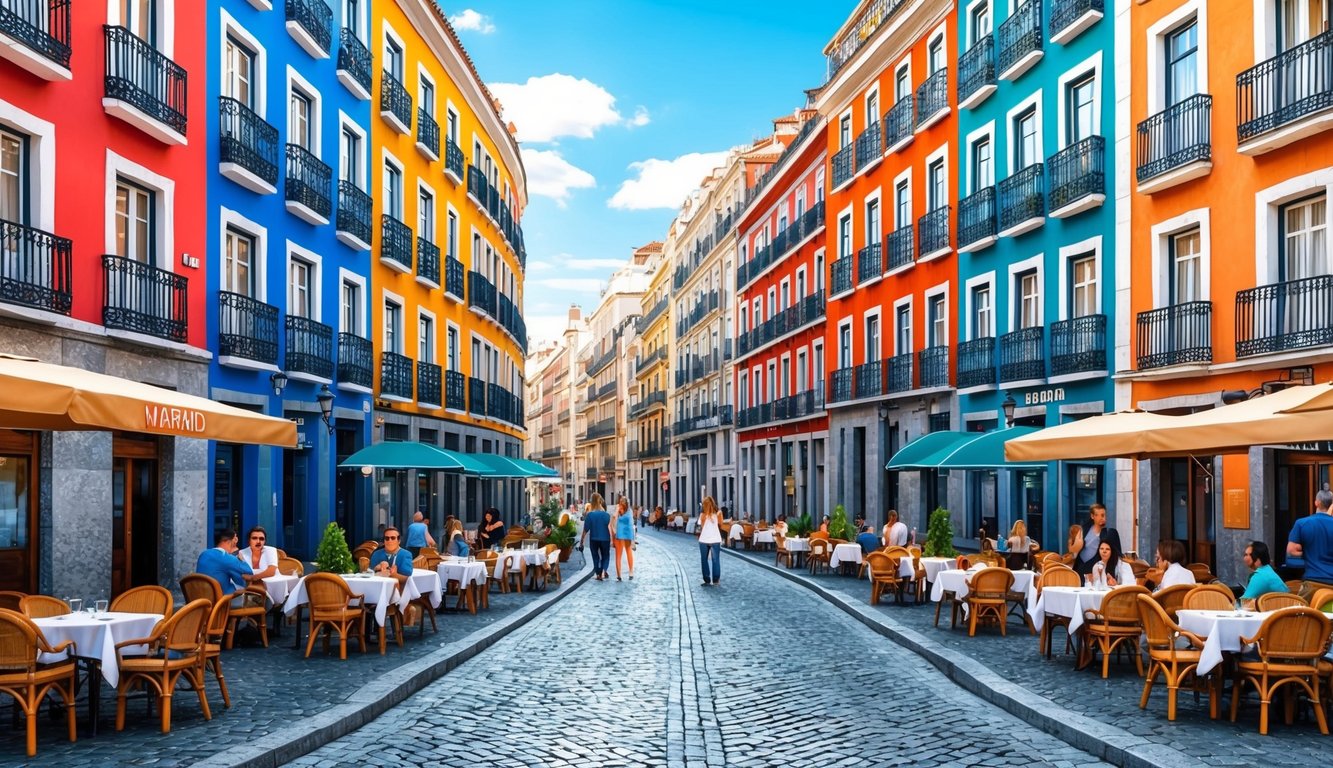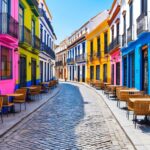Madrid, the vibrant capital of Spain, awaits you with its rich history, lively culture, and stunning architecture. Whether you are exploring world-famous art museums or indulging in delicious tapas, this city offers a unique blend of experiences that capture the heart of Spain. From the moment you arrive, the energy of Madrid fills the air, inviting you to discover its many secrets.
As a bustling financial and cultural center, Madrid is not just the largest city in Spain; it’s also a hub of creativity and diversity. Its charming neighborhoods, such as Malasaña and La Latina, boast delightful cafés, shops, and local markets.
With its beautiful parks and striking landmarks, like the Royal Palace and the iconic Plaza Mayor, every corner of Madrid tells a story just waiting to be uncovered.
Get ready to immerse yourself in the sights, sounds, and flavors that make Madrid special. From its lively nightlife to its rich sporting culture, there’s something for everyone in this incredible city.
Key Takeaways
- Discover historical landmarks and artistic treasures throughout the city.
- Enjoy a diverse culinary scene with exciting local flavors.
- Experience vibrant neighborhoods and lively atmosphere that characterize Madrid.
History and Culture
Madrid has a rich tapestry of history and culture that shapes its character today. From its historic roots as a prominent fortress to its vibrant arts scene, the city offers a glimpse into Spain’s past and present.
Historic Roots and Major Events
Madrid’s history dates back to the 9th century when it was known as Magerit. It started as a small Muslim settlement built around a fortress overlooking the Manzanares River. The city has witnessed many significant events, including the capture of Madrid by King Alfonso VI in 1083.
Over the centuries, Madrid evolved into the capital of the Spanish Empire in the 16th century. This designation increased its importance in global trade and culture. The city walls, remnants of which you can still see, protected the city during various conflicts. Major events, like the Spanish Civil War in the 1930s, shaped its landscape and society.
Cultural Tapestry
Madrid’s culture is a blend of historical influences and modern life. You’ll find traditional Spanish customs interwoven with contemporary styles. The city is known for its festivals, such as Las Fiestas de San Isidro, celebrating the patron saint of Madrid.
Cuisine is a crucial part of this culture. Trying tapas or enjoying a cocido madrileno will give you a taste of local flavors. The city’s diverse population, drawn from various parts of Spain and beyond, adds to this vibrant mix.
Artistic Legacy
Madrid is famous for its artistic legacy. The Golden Triangle of Art features three major museums: the Prado, the Reina Sofia, and the Thyssen-Bornemisza. These institutions house works from renowned artists like Velázquez, Goya, and Picasso.
Street art also thrives in neighborhoods like Malasaña, reflecting the contemporary spirit of Madrid. Additionally, the influence of the Spanish Empire is evident in the grand architecture and public spaces. As you stroll through the city, keep an eye out for these artistic expressions that highlight Madrid’s journey through time.
Landmarks and Attractions

Madrid is filled with stunning landmarks and attractions that showcase its rich history and culture. From the magnificent royal palace to the iconic squares, there’s something for everyone to enjoy.
Royal Palace Exploration
Visiting the Royal Palace in Madrid is a must. This impressive structure is the official residence of the Spanish royal family and boasts over 3,000 rooms. You can explore the grand halls and see remarkable artwork, including pieces by Goya and Velázquez.
Don’t miss the Royal Armory, which houses a collection of historic weapons and armor. The palace is surrounded by beautiful gardens, making it a perfect spot for a leisurely stroll. Plus, guided tours offer fascinating insights into the palace’s history.
The Iconic Plaza Mayor
Plaza Mayor is another highlight of your trip. This large, rectangular plaza is framed by stunning architecture and is a hub of activity. It’s ideal for people-watching while sipping coffee at one of the many outdoor cafes.
The plaza has a rich history dating back to the 17th century, serving various purposes from market space to bullfighting arena. Be sure to look for the statue of King Philip III at the center, which adds a regal touch to this vibrant spot.
Ancient Egypt in Madrid: Templo de Debod
A unique gem in Madrid is the Templo de Debod. This ancient Egyptian temple was built around 200 BC and relocated to Spain in 1968. It’s one of the few examples of Egyptian architecture outside Egypt.
Visiting at sunset is particularly stunning as it offers breathtaking views over the city. You can explore the temple’s interior and learn about its history, making for an enriching experience. This site beautifully combines culture and scenic landscapes.
Art and Museums
Madrid is a vibrant city filled with stunning art and impressive museums. You’ll find a mix of classical masterpieces and modern works that will inspire any art lover.
The Golden Triangle of Art
In Madrid, the Golden Triangle of Art is a must-see. This area includes three of the city’s most famous museums: the Museo del Prado, the Reina Sofía, and the Thyssen-Bornemisza.
- Museo del Prado: Home to a vast collection of European art.
- Reina Sofía: Focuses on modern and contemporary pieces.
- Thyssen-Bornemisza: Offers a diverse range of artworks from different periods.
Together, these museums create a rich tapestry of art history that you won’t want to miss.
Prado’s Masterpieces
The Museo del Prado is particularly renowned for its collection. Here, you can see iconic works by Spanish masters such as Diego Velázquez and Francisco Goya.
One of the highlights is Velázquez’s famous painting, Las Meninas. This complex masterpiece invites viewers to ponder the nature of reality and art. Goya’s works, like The Third of May 1808, showcase emotional depth and historical significance.
The museum also features pieces from other European artists, including Caravaggio. With thousands of works, every visit reveals something new.
Reina Sofía and Modern Art
The Reina Sofía is a treasure trove of modern art. It houses works from some of the most important Spanish artists of the 20th century.
One of the most famous pieces is Pablo Picasso’s Guernica. This powerful mural depicts the horrors of war and stands as a symbol of peace. You’ll also find works by Salvador Dalí, showcasing his unique surrealism.
The museum’s layout allows for an engaging experience, with exhibitions that change frequently, making each visit worthwhile.
The World of Thyssen-Bornemisza
The Thyssen-Bornemisza Museum completes the Golden Triangle. This collection is remarkable for its variety and range.
It features pieces from the Italian Renaissance to 20th-century modern art. You can find works by both renowned and lesser-known artists.
Key highlights include pieces by Van Gogh and Lichtenstein, providing a contrast to the classical art in the nearby museums. The museum’s café offers a nice break, letting you reflect on all the art you’ve seen.
Visiting these museums offers a deep dive into the world of art and history, making your trip to Madrid unforgettable.
Parks and Public Spaces
Madrid is home to beautiful parks and lively public spaces that offer a great escape from the city’s hustle. Two highlights are Retiro Park, perfect for relaxation, and the vibrant El Rastro flea market, where you can hunt for unique treasures.
Relax at Retiro Park
Retiro Park, or Parque del Buen Retiro, is a must-visit for anyone in Madrid. This stunning park covers over 125 hectares, making it an ideal spot for leisurely strolls.
You’ll find lovely gardens, charming lakes, and impressive sculptures scattered throughout. Rent a rowboat on the lake or simply enjoy the peaceful atmosphere. Don’t miss the Crystal Palace, a beautiful glass structure hosting art exhibitions.
On weekends, the park buzzes with local musicians and performers. Pack a picnic, grab a book, and spend a sunny afternoon in this urban oasis.
Flea Market Finds at El Rastro
El Rastro is Madrid’s famous flea market that operates every Sunday, attracting locals and tourists alike. It stretches from La Latina to the Ronda de Toledo, filled with stalls offering everything from vintage clothing to handmade crafts.
You can sift through countless treasures, including antiques and unique souvenirs. Bargaining is part of the fun, so don’t hesitate to haggle for a better price.
The atmosphere is lively, with street performers and food stalls lining the streets. Enjoy some tapas or a refreshing drink as you explore. El Rastro is not just a shopping experience; it’s a lively cultural event that showcases the heart of Madrid.
Culinary Adventures

Madrid offers a vibrant food scene that combines tradition and innovation. From the lively atmosphere of tapas bars to the elegance of fine dining, the city’s culinary options are plentiful. Each experience reveals something unique about Madrid’s culture.
Tapas and Tradition
When in Madrid, indulging in tapas is a must. These small plates are perfect for sharing and sampling a variety of flavors. Common tapas include patatas bravas, fried potatoes served with a spicy sauce, and croquetas, meat or fish-filled fritters.
You can find tapas in many neighborhoods, but the bustling neighborhoods like Malasaña and Chueca are especially popular. Don’t forget to try a classic tortilla Española, a traditional Spanish omelet made with potatoes and onions. Pair your tapas with a glass of sangría or local Spanish wine for an authentic experience.
This casual dining style encourages conversation and mingling, making it a great way to soak up the local nightlife.
High-End Dining
If you’re looking to treat yourself, Madrid has some fantastic high-end restaurants. These establishments focus on creativity and presentation, offering a more modern take on Spanish cuisine.
Restaurants like DiverXO and ** Ramón Freixa Madrid** have earned Michelin stars for their innovative dishes.
Expect to find tasting menus that showcase seasonal ingredients and unique flavors. You might encounter dishes like sous-vide octopus or wagyu beef, presented with artistic flair. The wine lists in these restaurants are extensive, featuring both local and international selections.
Dining at these top spots not only fills your belly but also creates an unforgettable culinary experience.
Explore La Latina
La Latina is one of the oldest neighborhoods in Madrid and is famous for its tapas bars. Strolling through its narrow streets, you’ll find countless spots to grab a bite to eat.
This area is especially lively on Sundays, when locals flock to El Rastro, a bustling flea market.
Must-try spots include Casa Lucio, known for its delicious huevos rotos, and La Taberna de la Daniela, famous for its traditional tapas.
Enjoying food in La Latina provides a glimpse into the local lifestyle, where food and community go hand in hand. The lively atmosphere makes it a top choice for both visitors and locals after dark, as the nightlife here brims with energy.
Sports and Entertainment
Madrid offers a vibrant mix of sports and entertainment that captures the spirit of the city. From thrilling football matches to traditional flamenco performances, there’s something for everyone. You’ll discover cultural experiences that showcase Madrid’s rich history and dynamic lifestyle.
Real Madrid FC
If you’re in Madrid, catching a Real Madrid FC game is a must. This historic football club plays at the iconic Santiago Bernabéu Stadium, where the atmosphere is electric. Home games attract passionate fans, and the stadium often fills to capacity. You can buy tickets online or at the stadium, but popular matches may sell out quickly.
Watching a match is not just about the game; it’s about the experience. Grab a snack from one of the nearby vendors, and enjoy the pre-game energy. If you can’t make it to a match, consider a stadium tour to see behind-the-scenes areas, including the trophy room and locker rooms.
Flamenco Nights
To experience authentic Spanish culture, you shouldn’t miss a flamenco show. Flamenco combines music, dance, and singing, creating an emotional experience. Venues like Tablao El Corral de la Morería and Casa Patas are famous for their traditional performances. You can expect passionate dancers, lively guitarists, and mesmerizing singers.
Shows typically last about an hour and may include a meal or tapas. Booking in advance is wise, especially for popular venues. Enjoy the intimate atmosphere, and don’t hesitate to join in the clapping to show your appreciation for the performers.
The Fashion Scene
Madrid is also a hub for fashion lovers. The city’s shopping districts, such as Gran Vía and Malasaña, offer a wide range of boutiques and designer stores. You can find everything from high-end fashion to unique local brands.
Fashion events like Madrid Fashion Week attract attention from designers and influencers alike. You can stroll through neighborhoods to discover pop-up shops and trendy cafes that showcase both style and creativity. Don’t forget to check out local markets for artisanal pieces that reflect Madrid’s artistic vibe.
Transportation and Accessibility
Navigating Madrid is straightforward thanks to its expansive public transport system, which makes getting around the city easy. Whether you’re traveling to and from the airport or using trains and buses, you’ll find options that suit your needs, including assistance for those requiring it.
Getting Around: Public Transport
Madrid boasts a robust public transport network that includes buses and a metro system. The Metro is particularly efficient, with connections to major areas like Gran Vía. Most metro stations are accessible for people with reduced mobility.
Buses are frequent and cover almost every corner of the city. If you need assistance, don’t hesitate to ask staff at the bus or metro stations. It’s helpful to obtain a multi-day travel pass for unlimited trips, making your travels seamless.
Madrid-Barajas Airport
Madrid-Barajas Airport is the main international gateway to the city. The airport is well-equipped with accessibility features, such as ramps and elevators. If you’re arriving or departing, you can find dedicated services for travelers with disabilities.
Public transport options from the airport include metro lines and buses, taking you directly to the city center. Be sure to check the schedules if you’re flying in late at night or early in the morning.
Navigating Train Stations
Train stations in Madrid, like Atocha and Chamartín, offer good accessibility for all passengers. They have elevators, ramps, and clear signage throughout. Services for those needing assistance can be arranged in advance.
Trains are an excellent way to explore beyond Madrid, and they frequently connect to other cities. Don’t forget to purchase your tickets ahead of time, especially during peak travel seasons, to secure your seat and avoid long lines at the station.
The Different Quarters

Madrid is a city filled with unique neighborhoods, each offering its own character and vibe. Discovering these barrios will help you connect with the heart of the capital of Spain.
Barrios With Character
Madrid’s neighborhoods, or barrios, have distinct personalities. For example, La Latina is famous for its tapas bars and lively Sunday market. It’s the perfect spot to sample authentic Spanish cuisine.
Malasaña is all about creativity and youth. You’ll find vintage shops, street art, and trendy cafes. It has a unique, vibrant atmosphere that’s great for exploring.
Then there’s Barrio de las Letras, a literary quarter where great Spanish writers once lived. The streets are lined with charming buildings and small bookstores, giving it a cultural touch.
Each barrio invites you to wander and enjoy what makes it special, like a diverse mix of history, culture, and food.
Life in Centro
Centro is the bustling heart of Madrid, where you feel the city’s energy. Here, Puerta del Sol serves as a central point. It’s both a hub for locals and a popular spot for tourists.
Strolling through the streets of Centro, you’ll find a mix of shops, restaurants, and historic landmarks. The atmosphere is always lively, especially around Plaza Mayor, known for its beautiful architecture.
Don’t miss exploring the small alleys filled with cozy cafes. You can stop in for a coffee or a bite to eat. The blend of modern life and historic charm makes Centro a must-visit for anyone.
In this area, you can soak up the culture and experience the rhythm of daily life in Madrid.
Frequently Asked Questions

When planning your trip to Madrid, you might have several questions about the best practices for visiting. Here are some common inquiries to help you navigate your adventure.
What’s the best time of year to visit Madrid?
The best time to visit Madrid is during the spring (March to May) and fall (September to November). The weather is mild and pleasant, which makes exploring the city more enjoyable. You’ll find fewer crowds compared to peak summer months.
Where should I stay when visiting Madrid?
Consider staying in areas like Malasaña, Chueca, or Salamanca for a vibrant experience. These neighborhoods offer a mix of restaurants, shops, and nightlife. They also provide easy access to public transport, making it simpler to explore other parts of the city.
What are the top attractions to see in Madrid?
Don’t miss the iconic Prado Museum, where you can see masterpieces by famous artists. Also, visit the Royal Palace for its stunning architecture and beautiful gardens. Other must-see spots include Retiro Park and Plaza Mayor, both offering a glimpse into Madrid’s history.
How do I get around the city when I’m in Madrid?
Madrid has an excellent public transport system, including buses and a metro that connects most areas of the city. Walking is also a great option, especially in central neighborhoods where sights are close together. Taxis and rideshare services are available for a more direct route.
Can you suggest some local dishes to try in Madrid?
Be sure to try tapas, which are small dishes meant for sharing. Specialties like patatas bravas and jamón ibérico are local favorites. Don’t forget to sample churros dipped in chocolate for a sweet treat after your meals.
What are the tips for budget travel in Madrid?
To save money, consider visiting museums on their free entry days. Eating at local markets can be cheaper and offers a taste of authentic Spanish cuisine. Using public transport instead of taxis will also help keep your expenses down while exploring the city.




